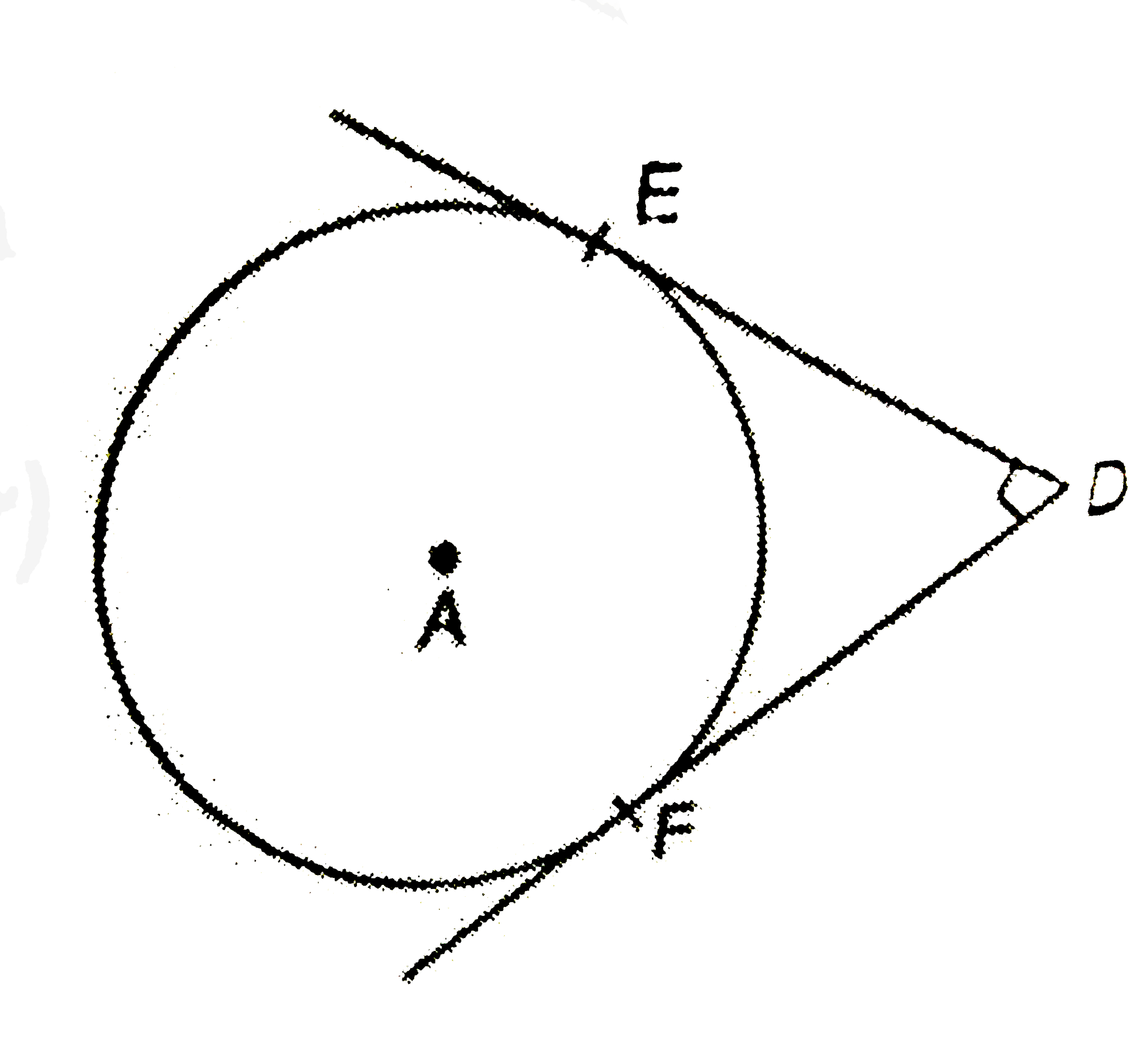In Fig. 10.99, DE and DF are tangents from an external point D to a circle with centre A . If DE=5cm and DE⊥DF , then the radius of the circle is (FIGURE) (a) 3cm (b) 5cm (c) 4cm (d) 6cm
To solve the problem step by step, we will follow the reasoning provided in the video transcript and apply the relevant geometric principles.
1. Identify the Given Information:
- We have a circle with center A.
- DE and DF are tangents from point D to the circle.
- The length of DE=5 cm.
- It is given that DE⊥DF.
2. Draw the Radius to the Point of Contact:
- Let E be the point of contact of tangent DE with the circle.
- Let F be the point of contact of tangent DF with the circle.
- Draw the radius AE from the center A to point E and the radius AF from the center A to point F.
3. Apply the Tangent-Radius Theorem:
- According to the theorem, the tangent at any point of a circle is perpendicular to the radius drawn to the point of contact.
- Therefore, AE⊥DE and AF⊥DF.
4. Analyze the Angles:
- Since DE⊥DF (given), we have a right angle at point D.
- This implies that angles AED, ADF, and EDF are all right angles (90 degrees).
5. Determine the Shape:
- Since all angles AED, EDF, and ADF are 90 degrees, quadrilateral AEDF is a square.
- In a square, all sides are equal.
6. Relate the Lengths:
- Since DE=5 cm, and all sides of the square are equal, we have:
AE=DE=DF=AF=5 cm
7. Conclusion:
- The radius of the circle, which is AE or AF, is therefore:
Radius of the circle=5 cm
Final Answer:
The radius of the circle is 5 cm.
- We have a circle with center A.
- DE and DF are tangents from point D to the circle.
- The length of DE=5 cm.
- It is given that DE⊥DF.
- Let E be the point of contact of tangent DE with the circle.
- Let F be the point of contact of tangent DF with the circle.
- Draw the radius AE from the center A to point E and the radius AF from the center A to point F.
- According to the theorem, the tangent at any point of a circle is perpendicular to the radius drawn to the point of contact.
- Therefore, AE⊥DE and AF⊥DF.
- Since DE⊥DF (given), we have a right angle at point D.
- This implies that angles AED, ADF, and EDF are all right angles (90 degrees).
- Since all angles AED, EDF, and ADF are 90 degrees, quadrilateral AEDF is a square.
- In a square, all sides are equal.
- Since DE=5 cm, and all sides of the square are equal, we have:
AE=DE=DF=AF=5 cm
- The radius of the circle, which is AE or AF, is therefore:
Radius of the circle=5 cm
The radius of the circle is 5 cm.
Topper's Solved these Questions
Similar Questions
In figure, DE and DF are tangents from an external point D to a circle with centre A. If DE = 5 cm and DE⊥DF, then find the radius of the circle.

View SolutionIf the area of a sector of a circle bounded by an arc of length 5π cm is equal to 20π cm2 , then the radius of the circle is
(a) 12 cm
(b) 16 cm
(c) 8 cm
(d) 10 cm
View SolutionIn Fig. 10.94, if AB=8cm and PE=3cm , then AE= (FIGURE) (a) 11cm (b) 7cm (c) 5cm (d) 3cm
View SolutionThe area of a circle is increased by 22 cm2 when its radius is increased by 1 cm. The original radius of the circle is (a)6 cm (b) 3 cm (c)4 cm (d) 3.5 cm
View SolutionABC is a right angled triangle, right angled at B such that BC=6cm and AB=8cm . A circle with centre O is inscribed in ABC . The radius of the circle is (a) 1cm (b) 2cm (c) 3cm (d) 4cm
View SolutionIf the length of a chord of a circle is 16 cm and is at a distance of 15 cm from the centre of the circle, then the radius of the circle is 15 cm (b) 16 cm (c) 17 cm (d) 34 cm
View SolutionFrom a point Q, the length of the tangent to a circle is 24 cm and the distance of Q from the centre is 25 cm. The radius of the circle is
(A) 7 cm (B) 12 cm (C) 15 cm (D) 24.5 cm
View SolutionAB and CD are two common tangents to circles which touch each other at C . If D lies on AB such that CD =4cm, then AB is equal to (a) 4cm (b) 6cm (c) 8cm (d) 12cm
View SolutionIn Fig. 4.244, if ∠ADE=∠ABC, then CE= (FIGURE) (a) 2 (b) 5 (c) 9/2 (d) 3
View SolutionIf ABCDEF such that AB=9.1cm and DE=6.5cm . If the perimeter of DEF is 25cm, then the perimeter of ABC is (a) 36cm (b) 30cm (c) 34cm (d) 35cm
View Solution
